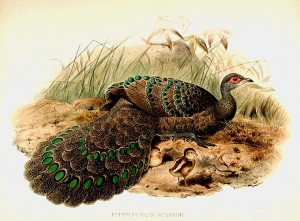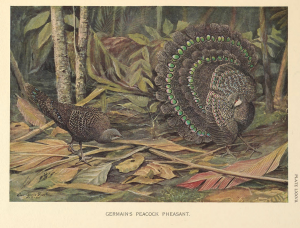Week 30 – 05 February 2017:
New Truths About Old Birds
The pages of august scholarly journals allow us to know what ornithologists were thinking about 150 years ago. Anyone interested in wading through old copies of such journals will find that bird biology then was very much like bird biology today. Our academic forbears were concerned with the lives of birds, and what caused those lives to be one way and not another. Once in a while, something completely new pops up.
In 1866, a paper appeared in Ibis, the journal of the British Ornithologists’ Union, describing a new species. The author, D. G. Elliot, wrote:
“I am indebted to the kindness of M. Jules Verreaux for the placing in my hands of a new Polyplectron, which in general appearance compares favourably with the handsomest of the known species of the genus. It was sent to the Museum of Paris from Cochin China by M. Germain, after whom I have the great pleasure of naming it.”

Hand-coloured lithograph after Joseph Wolf by J. Smit (from Elliot’s ‘A Monograph of the Phasianidae or Family of the Pheasants’)
Elliot provided the new scientific name, Polyplectron germaini, followed by a very brief description of the bird in Latin, a slightly longer English description of its appearance… and that was all. The report occupied less than a page. Elliot didn’t even reveal what sort of bird it was, assuming, I suppose, that everyone was familiar with the genus Polyplectron. He didn’t have anything to say about the bird’s natural history or abundance. I think the story is worth expanding upon.
The accepted common name for the new bird is Germain’s Peacock-pheasant. Daniel Giraud Elliot (1835 – 1915) was an American zoologist with professional ties to Paris and London. The gentleman who showed Elliot the stuffed bird was Jules Pierre Verreaux (1807 – 1873), a professional collector of natural history artifacts. By 1866 Verreaux had risen to the post of assistant curator of the museum that housed the pheasant, the Muséum national d’Histoire naturelle. The specimen remains in the museum, catalogued as number 1865-577.
The specimen of Germain’s Peacock-pheasant appears to have been collected in Cochinchina, representing the southern third of what is now Vietnam. In 1866 it was a French colony where Louis Rodolphe Germain (1827-1917) served as a veterinary surgeon to France’s colonial army. He probably shot and stuffed birds in his spare time.
This peacock-pheasant is a slightly chunky ground-dweller in Vietnamese forests. Overall it is black and brown, but with numerous large iridescent spots on its back, wings and tail. These spots appear green in some light and blue in others. The beautiful tail is between 22 and 35 cm (9 and 14 inches) long. Females are smaller and a bit duller than males. Its diet is a mystery, and everything we know about its breeding habits comes from birds in captivity.
As far as I can tell, only one additional scholarly paper has ever been published about Germain’s Peacock-pheasant. Destiny Omeire and his colleagues at Texas Southern University and the Houston Museum of Natural Science collected a sample of tissue from a museum specimen. When I asked about the origin of the specimen, Dan Brooks at the HMNS explained that it came from captive stock, rather than from the wild. Omeire and crew extracted genetic material from sub-cellular structures known as mitochondria, determined the complete sequence of the DNA’s constituent parts, and reported their findings in the journal Mitochondrial DNA. The paper’s corresponding author, Hector Miranda, wrote to say that students in his laboratory are sequencing DNA in other peacock-pheasants, and that he is preparing a manuscript “about the phytogeography and pattern of evolution of Polyplectron of Southeast Asia, as driven by climate change since the Pleistocene.”
One hundred and fifty year on, ornithologists are uncovering wonderful new things about birds discovered long ago.
Elliot, D. G. 1866. On a new species of the genus Polyplectron. Ibis 8:56.
Photo credits: Hand-coloured lithograph after Joseph Wolf by J. Smit from Elliot’s ‘A Monograph of the Phasianidae or Family of the Pheasants’ - www.donaldheald.com; Germain’s Peacock Pheasant by Louis Agassiz Fuertes – www.wikimedia.org


